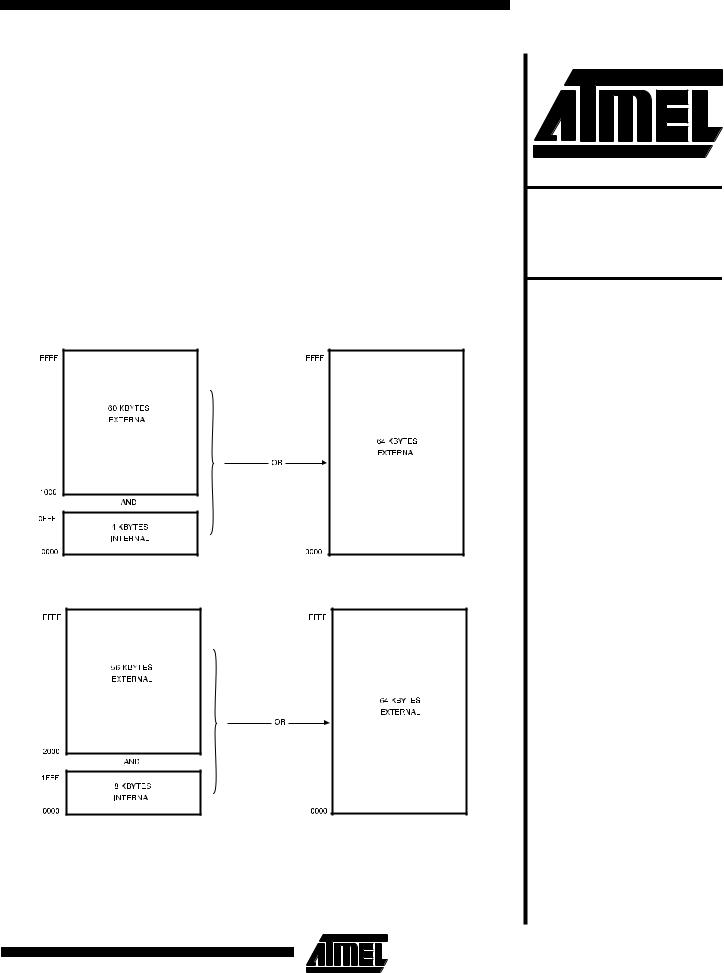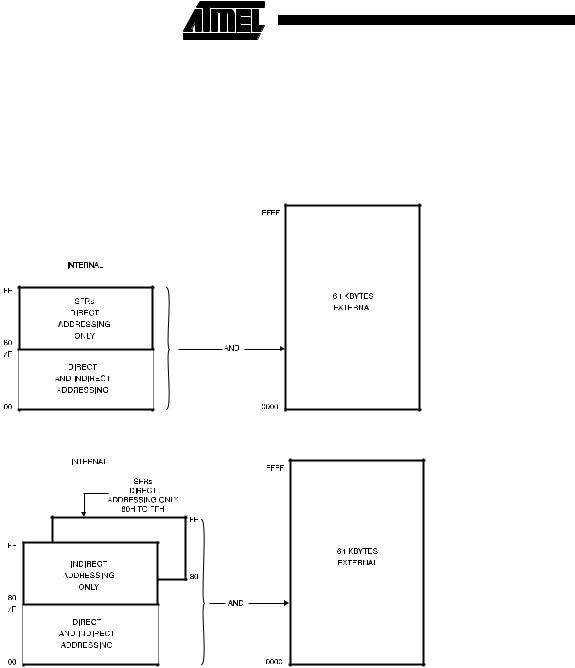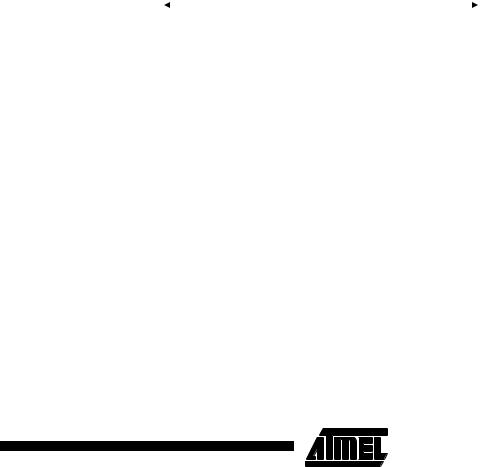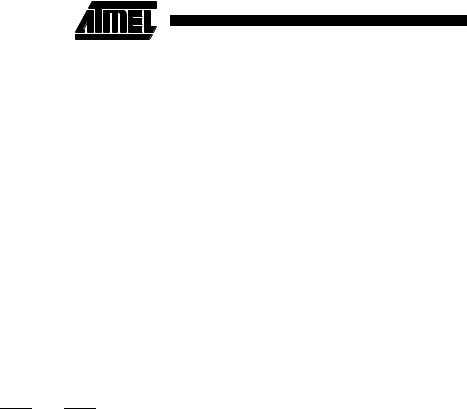
Организация памяти в микроконтроллерах семейства АТ89
.pdf
The information presented in this chapter is collected from the Microcontroller Architectural Overview, AT89C51, AT89LV51, AT89C52, AT89LV52, AT89C2051, and AT89C1051 data sheets of this book. The material has been selected and rearranged to form a quick and convenient reference for the programmers of Atmel’s microcontroller family of devices. This guide pertains specifically to the AT89C51, AT89LV51, AT89C52, and AT89LV52.
Memory Organization
Program Memory
The AT89C Microcontroller has separate address spaces for program memory and data memory. The program memory can be up to 64K bytes long. The lower addresses may reside on-chip.
Figure 1 shows a map of the AT89C51 program memory, and Figure 2 shows a map of the AT89C52 program memory. The AT89C1051/2051 do not have off-board memory expansion.
Figure 1. AT89C51 Program Memory
Figure 2. AT89C52 Program Memory
Flash |
Microcontroller |
Memory |
Organization |
0498B-B–12/97 |
2-21 |

Data Memory
The AT89C can directly address up to 64K bytes of data memory external to the chip. The MOVX instruction accesses the external data memory. (Refer to the Instruction Set section in this chapter for a detailed description of instructions).
Figure 3. A: The AT89C51 Data Memory
Figure 3. B: The AT89C52 Data Memory
The AT89C51 has 128 bytes of on-chip RAM (256 bytes in the AT89C52) plus a number of Special Function Registers (SFRs). The lower 128 bytes of RAM can be accessed either by direct addressing (MOV data addr) or by indirect addressing (MOV @Ri). Figure 3 shows the AT89C51 and the AT89C52 data memory organization.
2-22 Memory Organization 

 Memory Organization
Memory Organization
Indirect Address Area
In Figure 3b, the SFRs and the indirect address RAM have the same addresses (80H through 0FFH). Nevertheless, they are two separate areas and are accessed in two different ways.
For example, the following instruction writes 0AAH to Port 0, which is one of the SFRs.
MOV 80H, # 0AAH
The following instruction writes 0BBH in location 80H of the data RAM.
MOVR0, # 80H
MOV@ R0, # 0BBH
Thus, after executing both of these instructions, Port 0 contains 0AAH, and location 80H of the RAM contains 0BBH.
The stack operations are examples of indirect addressing, so the upper 128 bytes of data RAM are available as stack space in devices that implement 256 bytes of internal RAM.
Direct and Indirect Address Area
The 128 bytes of RAM that can be accessed by both direct and indirect addressing can be divided into 3 segments as described in this section and as shown in Figure 4.
1. Register Banks 0-3: Locations 0 through 1FH (32 bytes). Reset default is to register bank 0. To use the other
register banks, the user must select them in the software. Each register bank contains eight 1-byte registers, 0 through 7.
Reset initializes the Stack Pointer to location 07H. The Stack Pointer is then incremented once to start from location 08H, which is the first register (R0) of the second register bank. Thus, in order to use more than one register bank, the SP should be initialized to a different location of the RAM that is not used for data storage (that is, a higher part of the RAM).
2. Bit Addressable Area: 16 bytes have been assigned for this segment, 20H through 2FH. Each of the 128 bits of this segment can be directly addressed (0 through 7FH).
These bits can be referred to in two ways. One way is to refer to their addresses, that is, 0 to 7FH. The other way is with reference to bytes 20H to 2FH. Thus, bits 0 through 7 can also be referred to as bits 20.0 through 20.7, and bits 8 through FH are the same as 21.0 through 21.7, and so on.
Each of the 16 bytes in this segment can also be addressed as a byte.
3. Scratch Pad Area: Bytes 30H through 7FH are available to the user as data RAM. However, if the stack pointer has been initialized to this area, enough bytes should be left aside to prevent SP data destruction.
Figure 4. 128 Bytes of Directly and Indirectly Addressable RAM
|
|
|
8 Bytes |
|
|
|
|
|
|
|
|
|
|
|
|
|
|
|
|
||
|
|
|
|
|
|
|
|
|
|
|
|
|
|
|
|
|
|
|
|
|
|
78 |
|
|
|
|
|
|
|
7F |
|
|
70 |
|
|
|
|
|
|
|
77 |
|
|
|
|
|
|
|
|
|
|
|
||
68 |
|
|
|
|
|
|
|
6F |
|
|
|
|
|
|
|
|
|
|
|
||
60 |
|
|
|
|
|
|
|
67 |
|
|
|
|
|
|
|
|
|
|
|
||
58 |
|
|
|
|
|
|
|
5F |
SCRATCH |
|
|
|
|
|
|
|
|
||||
|
|
|
|
|
|
|
|
|
||
50 |
|
|
|
|
|
|
|
57 |
PAD |
|
|
|
|
|
|
|
|
||||
|
|
|
|
|
|
|
AREA |
|||
48 |
|
|
|
|
|
|
|
4F |
||
|
|
|
|
|
|
|
||||
|
|
|
|
|
|
|
|
|
||
40 |
|
|
|
|
|
|
|
47 |
|
|
|
|
|
|
|
|
|
|
|
||
38 |
|
|
|
|
|
|
|
3F |
|
|
|
|
|
|
|
|
|
|
|
||
30 |
|
|
|
|
|
|
|
37 |
|
|
|
|
|
|
|
|
|
|
|
||
|
|
|
|
|
|
|
|
|
|
|
28 |
|
|
|
. . . 7F |
|
|
2F |
BIT |
||
|
|
|
|
|
|
|
|
|
ADDRESSABLE |
|
|
0 . . . |
|
|
|
|
|
27 |
|||
20 |
|
|
|
|
|
SEGMENT |
||||
|
|
|
|
|
|
|
|
|
|
|
18 |
|
|
3 |
|
|
|
|
1F |
|
|
|
|
|
|
|
|
|
|
|
|
|
10 |
|
|
2 |
|
|
|
|
17 |
REGISTER |
|
|
|
|
|
|
|
|
|
0F |
BANKS |
|
08 |
|
|
1 |
|
|
|
|
|||
00 |
|
|
|
|
|
|
|
07 |
|
|
|
|
0 |
|
|
|
|
|
|
||
|
|
|
|
|
|
|
|
|
|
|
2-23

Special Function Registers
Table 1 contains a list of all the SFRs and their addresses.
All of the SFRs that are byteand bit-addressable are located on the first column of the diagram in Figure 5.
Table 1. Special Function Registers
Symbol |
|
Name |
Address |
|
|
|
|
ACC(1) |
|
Accumulator |
0E0H |
B(1) |
|
B Register |
0F0H |
PSW(1) |
|
Program Status Word |
0D0H |
SP |
|
Stack Pointer |
81H |
|
|
|
|
DPTR |
|
Data Pointer 2 Bytes |
|
|
|
|
|
DPL |
|
Low Byte |
82H |
|
|
|
|
DPH |
|
High Byte |
83H |
|
|
|
|
P0(1) |
|
Port 0 |
80H |
P1(1) |
|
Port 1 |
90H |
P2(1) |
|
Port 2 |
0A0H |
P3(1) |
|
Port 3 |
0B0H |
IP(1) |
|
Interrupt Priority Control |
0B8H |
IE(1) |
|
Interrupt Enable Control |
0A8H |
TMOD |
|
Timer/Counter Mode Control |
89H |
|
|
|
|
TCON(1) |
|
Timer/Counter Control |
88H |
T2CON(1)(2) |
Timer/Counter 2 Control |
0C8H |
|
T2MOD(2) |
|
Timer/Counter 2 Mode Control |
0C9H |
TH0 |
|
Timer/Counter 0 High Byte |
8CH |
|
|
|
|
TL0 |
|
Timer/Counter 0 Low Byte |
8AH |
|
|
|
|
TH1 |
|
Timer/Counter 1 High Byte |
8DH |
|
|
|
|
TL1 |
|
Timer/Counter 1 Low Byte |
8BH |
|
|
|
|
TH2(2) |
|
Timer/Counter 2 High Byte |
0CDH |
TL2(2) |
|
Timer/Counter 2 Low Byte |
0CCH |
RCAP2H(2) |
|
T/C 2 Capture Reg. High Byte |
0CBH |
RCAP2L(2) |
|
T/C 2 Capture Reg. Low Byte |
0CAH |
SCON(1) |
|
Serial Control |
98H |
SBUF |
|
Serial Data Buffer |
99H |
|
|
|
|
PCON |
|
Power Control |
87H |
|
|
|
|
Notes: 1. |
Bit addressable |
|
|
2. |
AT89C52 only |
|
|
2-24 Memory Organization 

 Memory Organization
Memory Organization
Contents of the SFRs Just After Power-On or a Reset
Table 2. Contents of the SFRs after power-on or a hardware reset
Register |
Value in Binary |
|
|
ACC(2) |
00000000 |
B(2) |
00000000 |
PSW(2) |
00000000 |
SP |
00000111 |
|
|
DPTR |
|
|
|
DPH |
00000000 |
|
|
DPL |
00000000 |
|
|
PO(2) |
11111111 |
P1(2) |
11111111 |
P2(2) |
11111111 |
P3(2) |
11111111 |
IP(2) |
80C51 XXX00000, |
|
80C52 XX000000 |
|
|
IE(2) |
80C51 0XX00000, |
|
80C52 0X000000 |
|
|
TMOD |
00000000 |
|
|
T2MOD(3) |
XXXXXX00 |
TCON(2) |
00000000 |
T2CON(2)(3) |
00000000 |
TH0 |
00000000 |
|
|
TL0 |
00000000 |
|
|
TH1 |
00000000 |
|
|
TL1 |
00000000 |
|
|
TH2(3) |
00000000 |
TL2(3) |
00000000 |
RCAP2H(3) |
00000000 |
RRAP2L(3) |
00000000 |
SCON(2) |
00000000 |
SBUF |
Indeterminate |
|
|
PCON |
CMOS 0XXX0000 |
|
|
Notes: 1. X = Undefined
2.Bit Addressable
3.AT89C52 only
2-25

Special Function Register Map
Figure 5. SFR Memory Map
|
|
|
|
|
8 Bytes |
|
|
|
|
|
|
F8 |
|
|
|
|
|
|
|
|
|
|
FF |
|
|
|
|
|
|
|
|
|
|
|
|
F0 |
|
B |
|
|
|
|
|
|
|
|
F7 |
E8 |
|
|
|
|
|
|
|
|
|
|
EF |
|
|
|
|
|
|
|
|
|
|
||
|
|
|
|
|
|
|
|
|
|
|
|
E0 |
|
ACC |
|
|
|
|
|
|
|
|
E7 |
D8 |
|
|
|
|
|
|
|
|
|
|
DF |
|
|
|
|
|
|
|
|
|
|
||
|
|
|
|
|
|
|
|
|
|
|
|
D0 |
|
PSW(1) |
|
|
|
|
|
|
|
|
D7 |
C8 |
T2CON(1)(2) |
T2MOD(2) |
RCAP2L(2) |
RCAP2H(2) |
|
TL2(2) |
TH2(2) |
|
|
CF |
|
C0 |
|
|
|
|
|
|
|
|
|
|
C7 |
|
|
|
|
|
|
|
|
|
|
|
|
B8 |
|
IP(1) |
|
|
|
|
|
|
|
|
BF |
B0 |
|
P3 |
|
|
|
|
|
|
|
|
B7 |
|
|
|
|
|
|
|
|
|
|
|
|
A8 |
|
IE(1) |
|
|
|
|
|
|
|
|
AF |
A0 |
|
P2 |
|
|
|
|
|
|
|
|
A7 |
|
|
|
|
|
|
|
|
|
|
|
|
98 |
|
SCON(1) |
SBUF |
|
|
|
|
|
|
|
9F |
90 |
|
P1 |
|
|
|
|
|
|
|
|
97 |
|
|
|
|
|
|
|
|
|
|
|
|
88 |
|
TCON(1) |
TMOD(1) |
TL0 |
TL1 |
|
TH0 |
TH1 |
|
|
8F |
80 |
|
P0 |
SP |
DPL |
DPH |
|
|
|
|
PCON(1) |
87 |
|
|
− Bit Addressable |
|
|
|
|
|
|
|
|
|
Notes: 1. |
SFRs converting mode or control bits |
|
|
|
|
|
|
|
|||
|
2. |
AT89C52 only |
|
|
|
|
|
|
|
|
|
2-26 Memory Organization 

Memory Organization
SFRs whose bits are assigned for various functions are listed in this section. For more detailed information, refer to the Microcontroller Architectural Overview chapter of this book.
PSW: Program Status Word (Bit Addressable)
CY |
|
AC |
F0 |
|
RS1 |
RS0 |
|
OV |
— |
|
P |
|
|
|
|
|
|
|
|
|
|
|
|
CY |
|
PSW.7 |
Carry flag. |
|
|
|
|
|
|
|
|
AC |
|
PSW.6 |
Auxiliary carry flag. |
|
|
|
|
|
|
|
|
F0 |
|
PSW.5 |
Flag 0 available to the user for general purpose. |
|
|
|
|
|
|||
RS1 |
|
PSW.4 |
Register Bank selector bit 1.(1) |
|
|
|
|
|
|
||
RS0 |
|
PSW.3 |
Register Bank selector bit 0. (1) |
|
|
|
|
|
|
||
OV |
|
PSW.2 |
Overflow flag. |
|
|
|
|
|
|
|
|
— |
|
PSW.1 |
User definable flag. |
|
|
|
|
|
|
|
|
P |
|
PSW.0 |
Parity flag. Set/cleared by hardware each instruction cycle to indicate an odd/even number of 1 bits |
||||||||
|
|
|
in the accumulator. |
|
|
|
|
|
|
|
|
Note: 1. |
The values of RS0 and RS1 select the corresponding register bank. |
|
|
|
|
|
|||||
|
|
|
|
|
|
|
|||||
|
RS1 |
RS0 |
|
Register Bank |
|
Address |
|||||
|
|
|
|
|
|
|
|
||||
|
0 |
0 |
|
|
0 |
|
00H-07H |
||||
|
|
|
|
|
|
|
|
||||
|
0 |
1 |
|
|
1 |
|
08H-0FH |
||||
|
|
|
|
|
|
|
|
||||
|
1 |
0 |
|
|
2 |
|
10H-17H |
||||
|
|
|
|
|
|
|
|
||||
|
1 |
1 |
|
|
3 |
|
18H-1FH |
||||
|
|
|
|
|
|
|
|
|
|
|
|
PCON: Power Control Register (Not Bit Addressable)
SMOD |
— |
— |
— |
GF1 |
GF0 |
PD |
IDL |
|
|
|
|
|
|
|
|
SMOD |
Double baud rate bit. If Timer 1 is used to generate baud rate and SMOD = 1, the baud rate is doubled when the |
||||||
|
Serial Port is used in modes 1, 2, or 3. |
|
|
|
|
||
—Not implemented, reserved for future use. (1)
—Not implemented, reserved for future use. (1)
—Not implemented, reserved for future use. (1)
GF1 |
General purpose flag bit. |
GF0 |
General purpose flag bit. |
PD |
Power Down bit. Setting this bit activates Power Down operation in the AT89C51. |
IDL |
Idle Mode bit. Setting this bit activates Idle Mode operation in the AT89C51. |
If 1s are written to PD and IDL at the same time, PD takes precedence.
Note: 1. User software should not write 1s to reserved bits. These bits may be used in future microcontrollers to invoke new features. In that case, the reset or inactive value of the new bit will be 0, and its active value will be 1.
2-27

Interrupts
In order to use any of the interrupts in the Flash microcontroller, take the following three steps.
1.Set the EA (enable all) bit in the IE register to 1.
2.Set the corresponding individual interrupt enable bit in the IE register to 1.
3.Begin the interrupt service routine at the corresponding Vector Address of that interrupt. See the following table.
Interrupt Source |
Vector Address |
|
|
IE0 |
0003H |
|
|
TF0 |
000BH |
|
|
IE1 |
0013H |
|
|
TF1 |
001BH |
|
|
R1 & T1 |
0023H |
|
|
TF2 & EXF2(1) |
002BH |
Note: 1. AT89C52 only.
In addition, for external interrupts, pins INT0 and INT1 (P3.2 and P3.3) must be set to 1, and depending on whether the interrupt is to be level or transition activated, bits IT0 or IT1 in the TCON register may need to be set to 1.
ITx = 0 level activated
ITx = 1 transition activated
IE: Interrupt Enable Register (Bit Addressable)
If the bit is 0, the corresponding interrupt is disabled. If the bit is 1, the corresponding interrupt is enabled.
EA |
|
— |
ET2 |
ES |
ET1 |
|
EX1 |
|
ET0 |
EX0 |
|
|
|
|
|
|
|
|
|
||
EA |
|
IE.7 |
Disables all interrupts. If EA = 0, no interrupt is acknowledged. If EA = 1, each interrupt source is |
|||||||
|
|
|
individually enabled or disabled by setting or clearing its enable bit. |
|
|
|||||
— |
|
IE.6 |
Not implemented, reserved for future use. (1) |
|
|
|
|
|||
ET2 |
|
IE.5 |
Enables or disables the Timer 2 overflow or capture interrupt (AT89C52 only). |
|
||||||
ES |
|
IE.4 |
Enables or disables the serial port interrupt. |
|
|
|
|
|||
ET1 |
|
IE.3 |
Enables or disables the Timer 1 overflow interrupt. |
|
|
|
|
|||
EX1 |
|
IE.2 |
Enables or disables External Interrupt 1. |
|
|
|
|
|||
ET0 |
|
IE. 1 |
Enables or disables the Timer 0 overflow interrupt. |
|
|
|
|
|||
EX0 |
|
IE.0 |
Enables or disables External Interrupt 0. |
|
|
|
|
|||
Note: 1. |
User software should not write 1s to reserved bits. These bits may be used in future Flash microcontrollers to invoke new |
|||||||||
|
features. In that case, the reset or inactive value of the new bit will be 0, and its active value will be 1. |
|
||||||||
2-28 Memory Organization 

Memory Organization
Assigning Higher Priority to One or More Interrupts
In order to assign higher priority to an interrupt the corresponding bit in the IP register must be set to 1.
While an interrupt service is in progress, it cannot be interrupted by an interrupt of the same or lower priority.
Priority Within Level
The only purpose of priority within a level is to resolve simultaneous requests of the same priority level.
From high to low, interrupt sources are listed below.
IE0
TF0
IE1
TF1
RI or TI
TF2 or EXF2
IP: Interrupt Priority Register (Bit Addressable)
If the bit is 0, the corresponding interrupt has a lower priority. If the bit is 1, the corresponding interrupt has a higher priority
— |
|
— |
PT2 |
PS |
PT1 |
PX1 |
PT0 |
PX0 |
|
|
|
|
|
|
|
|
|
— |
|
IP. 7 |
Not implemented, reserved for future use. (1) |
|
|
|
||
— |
|
IP. 6 |
Not implemented, reserved for future use. (1) |
|
|
|
||
PT2 |
|
IP. 5 |
Defines the Timer 2 interrupt priority level (AT89C52 only). |
|
|
|||
PS |
|
IP. 4 |
Defines the Serial Port interrupt priority level. |
|
|
|
||
PT1 |
|
IP. 3 |
Defines the Timer 1 interrupt priority level. |
|
|
|
||
PX1 |
|
IP. 2 |
Defines External Interrupt 1 priority level. |
|
|
|
||
PT0 |
|
IP. 1 |
Defines the Timer 0 interrupt priority level. |
|
|
|
||
PX0 |
|
IP. 0 |
Defines the External Interrupt 0 priority level. |
|
|
|
||
Note: 1. |
User software should not write 1s to reserved bits. These bits may be used in future Flash microcontrollers to invoke new |
|||||||
|
features. In that case, the reset or inactive value of the new bit will be 0, and its active value will be 1. |
|
||||||
2-29

TCON: Timer/Counter Control Register (Bit Addressable)
TF1 |
TR1 |
TF0 |
|
TR0 |
|
IE1 |
|
IT1 |
IE0 |
IT0 |
|
|
|
|
|
|
|
|
|||
TF1 |
TCON. 7 |
Timer 1 overflow flag. Set by hardware when the Timer/Counter 1 overflows. Cleared by hardware |
||||||||
|
|
as the processor vectors to the interrupt service routine. |
|
|
|
|||||
TR1 |
TCON. 6 |
Timer 1 run control bit. Set/cleared by software to turn Timer/Counter 1 ON/OFF. |
|
|||||||
TF0 |
TCON. 5 |
Timer 0 overflow flag. Set by hardware when the Timer/Counter 0 overflows. Cleared by hardware |
||||||||
|
|
as the processor vectors to the service routine. |
|
|
|
|||||
TR0 |
TCON. 4 |
Timer 0 run control bit. Set/cleared by software to turn Timer/Counter 0 ON/OFF. |
|
|||||||
IE1 |
TCON. 3 |
External Interrupt 1 edge flag. Set by hardware when the External Interrupt edge is detected. |
||||||||
|
|
Cleared by hardware when the interrupt is processed. |
|
|
|
|||||
IT1 |
TCON. 2 |
Interrupt 1 type control bit. Set/cleared by software to specify falling edge/low level triggered |
||||||||
|
|
External Interrupt. |
|
|
|
|
|
|
|
|
IE0 |
TCON. 1 |
External Interrupt 0 edge flag. Set by hardware when External Interrupt edge detected. Cleared by |
||||||||
|
|
hardware when interrupt is processed. |
|
|
|
|
|
|||
IT0 |
TCON. 0 |
Interrupt 0 type control bit. Set/cleared by software to specify falling edge/low level triggered |
||||||||
|
|
External Interrupt. |
|
|
|
|
|
|
|
|
TMOD: Timer/Counter Mode Control Register (Not Bit Addressable)
|
|
|
|
|
|
|
|
Timer 1 |
|
|
|
|
|
|
|
Timer 0 |
|
|||
|
|
|
|
|
|
|
|
|
|
|
|
|
|
|
|
|
|
|||
GATE |
|
|
|
|
|
|
|
M1 |
|
M0 |
GATE |
|
|
|
|
M1 |
M0 |
|||
|
C/T |
|
|
|
|
C/T |
|
|||||||||||||
|
|
|
|
|
|
|
|
|
|
|
|
|||||||||
GATE |
When TRx (in TCON) is set and GATE = 1, TIMER/COUNTERx runs only while the INTx pin is high (hardware |
|||||||||||||||||||
|
|
|
|
control). When GATE = 0, TIMER/COUNTERx will run only while TRx = 1 (software control). |
|
|||||||||||||||
|
|
|
|
Timer or Counter selector. Cleared for Timer operation (input from internal system clock). Set for Counter operation |
||||||||||||||||
C/T |
|
|
||||||||||||||||||
|
|
|
|
(input from Tx input pin). |
|
|
|
|
|
|
|
|
|
|||||||
M1 |
Mode selector bit.(1) |
|
|
|
|
|
|
|
|
|
|
|||||||||
M0 |
Mode selector bit.(1) |
|
|
|
|
|
|
|
|
|
|
|||||||||
Note: 1. |
|
|
|
|
|
|
|
|
|
|
|
|
|
|
|
|
|
|||
|
|
|
|
|
|
|
|
|
|
|
|
|
|
|
|
|
|
|
||
|
|
|
|
M1 |
|
|
|
M0 |
|
Operating Mode |
|
|
|
|
|
|
|
|||
|
|
|
|
|
|
|
|
|
|
|
|
|
|
|
|
|
|
|||
|
|
|
|
0 |
|
0 |
|
|
0 |
13-bit Timer |
|
|
|
|
|
|
|
|||
|
|
|
|
|
|
|
|
|
|
|
|
|
|
|
|
|
|
|||
|
|
|
|
0 |
|
1 |
|
|
1 |
16-bit Timer/Counter |
|
|
|
|
|
|
|
|||
|
|
|
|
|
|
|
|
|
|
|
|
|
|
|
|
|
||||
|
|
|
|
1 |
|
0 |
|
|
2 |
8-bit Auto-Reload Timer/Counter |
|
|
|
|
|
|
||||
|
|
|
|
|
|
|
|
|
|
|
|
|
||||||||
|
|
|
|
1 |
|
1 |
|
|
3 |
Split Timer Mode: (Timer 0) TL0 is an 8-bit Timer/Counter controlled by the standard Timer 0 |
||||||||||
|
|
|
|
|
|
|
control bits, TH0 is an 8-bit Timer and is controlled by Timer 1 control bits. |
|
||||||||||||
|
|
|
|
|
|
|
|
|
|
|
|
|
||||||||
|
|
|
|
|
|
|
|
|
|
|
|
|
|
|
|
|
||||
|
|
|
|
1 |
|
1 |
|
|
3 |
(Timer 1) Timer/Counter 1 stopped. |
|
|
|
|
|
|
||||
|
|
|
|
|
|
|
|
|
|
|
|
|
|
|
|
|
|
|
|
|
2-30 Memory Organization 
